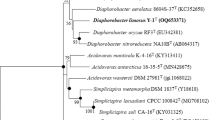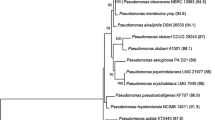Abstract
Herein, a denitrifying bacterium that produced greenish fluorescent pigment under aerobic conditions was accidentally isolated from municipal sewage sludge. Using 16S-rDNA sequence analysis, we identified the isolate as Pseudomonas aeruginosa R12, with 100% similarity. We achieved the highest pigment production rate (1.36 mg/L/h) in a 1-L bioreactor under aerobic conditions, using the optimal culture parameters determined in this study: 37°C, pH 8.0, 200 rpm, 5 wm aeration, and medium containing succinate and (NH4)2SO4. The pigment was not a secondary metabolite and had no antibacterial activity on its co-isolates. Under anaerobic conditions, the isolate produced mainly N2 and behaved as a strong denitrifier, displaying synergistic denitrification with co-isolated denitrifiers. To our knowledge, herein we have described the first instance in which P. aeruginosa R12 produces a fluorescent pigment under aerobic conditions. This newly-isolated strain therefore shows potential as a commercial resource for natural pigment.
Similar content being viewed by others
References
Jeter, R. M. and J. L. Ingraham (1981) The Denitrifying Prokrayotes: The Prokaryotes. Vol. II, Springer-Verlag, Berlin, Heidelberg, New York, NY, USA.
Lim, S. J., Y. H. Ahn, E. Y. Kim, and H. N. Chang (2006) Nitrate removal in a packed bed reactor using volatile fatty acids from anaerobic acidogenesis of food wastes. Biotechnol. Bioprocess Eng. 11: 538–543.
Cho, Y. J., H. J. Hwang, S. W. Kim, C. H. Song, and J. W. Yun (2002) Effect of carbon source and aeration rate on broth rheology and fungal morphology during red pigment production by Paecilomyces sinclairii in a batch bioreactor. J Biotechnol. 95: 13–23.
Dziezak, J. D. (1987) Applications of food colorants. Food Technol. 41: 78–80.
Fenice, M., F. Federici, L. Selbmann, and M. Petruccioli (2000) Repeated-batch production of pigments by immobilized Monascus purpureus. J. Biotechnol. 80: 271–276.
Francis, F. J. (1989) Food colorants: anthocyanins. Crit. Rev. Food Sci. Nutr. 28: 273–314.
Kim, J. K., S. M. Park, and S. J. Lee (1995) Novel antimutagenic pigment produced by Bacillus licheniformis SSA3. J Microbiol. Biotechnol. 5: 48–50.
Masahiro, K. O., K. Mine, M. Taya, S. Tone, and T. Ichi (1994) Production and release of anthraquinone pigments by hairy roots of madder (Rubia tinctorum L.) under improved culture conditions. J Ferment. Bioeng. 77: 103–106.
Lauro, G. J. (1991) A primer on natural colors. Cereal Foods World 36: 949–953.
Gray, C. T., N. J. Jacobs, and S. Ely (1973) A new cytochrome b-like pigment with a peak at 567 nm and a low redox potential in denitrifying bacteria. Biochim. Biophys. Acta 325: 72–80.
Jacobs, N. J. and J. M. Jacobs (1976) Nitrate, fumarate, and oxygen as electron acceptors for a late step in microbial heme synthesis. Biochim. Biophys. Acta 449: 1–9.
Barbhaiya, H. B. and K. K. Rao (1985) Production of pyoverdine, the fluorescent pigment of Pseudomonas aeruginosa PAO1. FEMS Microbiol. Lett. 27: 233–235.
Fava, F., D. D. Gioia, and L. Marchetti (1993) Characterization of a pigment produced by Pseudomonas fluorescens during 3-chlorobenzoate co-metabolism. Chemosphere 27: 825–835.
Vijayan, K. K., I. S. Bright Singh, N. S. Jayaprakash, S. V. Alavandi, S. Somnath Pai, R. Preetha, J. J. S. Rajan, and T. C. Santiago (2006) A brackishwater isolate of Pseudomonas PS-102, a potential antagonistic bacterium against pathogenic vibrios in penaeid and non-penaeid rearing systems. Aquaculture 251: 192–200.
Kim, J. K., S.-K. Kim, and S.-H. Kim (2001) Characterization of immobilized denitrifying bacteria isolated from municipal sewage. J. Microbiol. Biotechnol. 11: 756–762.
Kim, J. K., J. B. Kim, K. S. Cho, and Y.-K. Hong (2007) Isolation and identification of microorganisms and their aerobic biodegradation of fish-meal wastewater for liquid-fertilization. Int. Biodeterior. Biodegradation 59: 156–165.
Altschul, S. F., T. L. Madden, A. A. Schaffer, J. Zhang, Z. Zhang, W. Miller, and D. J. Lipman (1997) Gapped BLAST and PSI-BLAST: a new generation of protein database search programs. Nucleic Acids Res. 25: 3389–3402.
Gauthier, M. J. and G. N. Flatau (1976) Antibacterial activity of marine violet-pigmented Alteromonas with special reference to the production of brominated compounds. Can. J. Microbiol. 22: 1612–1619.
Massengale, A. R. D., R. A. Ollar, S. J. Giordano, M. S. Felder, and S. C. Aronoff (1999) Use of the paraffin wax baiting system for identification of Pseudomonas aeruginosa clinical isolates. Diagn. Microbiol. Infect. Dis. 35: 177–183.
Neter, J., W. Wasserman, and M. H. Kutner (1985) Applied Linear Statistical Models. 2nd ed., pp. 574–579. IRWIN, Homewood, IL, USA.
Sivaprakasam, S., S. Mahadevan, and M. Bhattacharya (2007) Biocalorimetric and respirometric studies on metabolic activity of aerobically grown batch culture of Pseudomonas aeruginosa. Biotechnol. Bioprocess Eng. 12: 340–347.
Oh, K.-T., C.-M. Kang, M. Kubo, and S.-Y. Chung (2006) Culture condition of Pseudomonas aeruginosa F722 for biosurfactant production. Biotechnol. Bioprocess Eng. 11:471–476.
Adris, P. and K.-T. Chung (2006) Metabolic activation of bladder procarcinogens, 2-aminofluorene, 4-aminobiphenyl, and benzidine by Pseudomonas aeruginosa and other human endogenous bacteria. Toxicol. In Vitro 20: 367–374.
Fernandez, R. O. and R. A. Pizarro (1997) High-performance liquid chromatographic analysis of Pseudomonas aeruginosa phenazines. J. Chromatogr. A 771: 99–104.
Hassen, A., N. Saidi, M. Cherif, and A. Boudabous (1998) Effects of heavy metals on Pseudomonas aeruginosa and Bacillus thuringiensis. Bioresour. Technol. 65: 73–82.
Nakamura, Y., T. Sawada, Y. Morita, and E. Tamiya (2002) Isolation of a psychrotrophic bacterium from the organic residue of a water tank keeping rainbow trout and antibacterial effect of violet pigment produced from the strain. Biochem. Eng. J. 12: 79–86.
Poiata, A., A. Vlahovici, and D.-E. Creanga (2005) Ferrofluid effect on Pseudomonas pyoverdine. J. Magn. Magn. Mater. 289: 455–458.
Reszka, K. J., Y. O’Malley, M. L. McCormick, G. M. Denning, and B. E. Britigan (2004) Oxidation of pyocyanin, a cytotoxic product from Pseudomonas aeruginosa, by microperoxidase 11 and hydrogen peroxide. Free Radic. Biol. Med. 36: 1448–1459.
King, E. O., M. K. Ward, and D. E. Raney (1954) Two simple media for the determination of pyocyanin and fluorescein. J. Lab. Clin. Med. 44: 301–307.
Carlson, C. A. and J. L. Ingraham (1983) Comparison of denitrification by Pseudomonas stutzeri, Pseudomonas aeruginosa, and Paracoccus denitrificans. Appl. Environ. Microbiol. 45: 1247–1253.
Fabregas, J., E. Morales, J. Aran, and A. Otero (1998) Germinated Solanum tuberosum: An agricultural product for marine microalgae culture. Bioresour. Technol. 66: 19–24.
Author information
Authors and Affiliations
Corresponding author
Rights and permissions
About this article
Cite this article
Kim, JB., Cho, KS., Jeong, SK. et al. Identification and characterization of a pigment-producing denitrifying bacterium. Biotechnol Bioproc E 13, 217–223 (2008). https://doi.org/10.1007/s12257-007-0201-y
Received:
Accepted:
Published:
Issue Date:
DOI: https://doi.org/10.1007/s12257-007-0201-y




